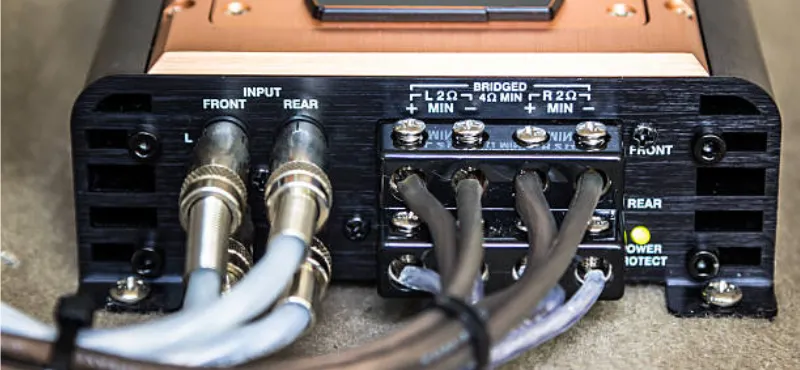Car audio is all about suitability.
It means whenever you’re about to replace/upgrade one of your car audio components, you’ll have to consider its compatibility with your existing components too.
For example, if you’re going to install a new subwoofer in your car, you must have a capable amplifier already in place too.
But buying a new amp altogether just for a sub doesn’t seem practical from a budget point of view, does it?
Luckily, there’s an amp feature called bridge mode. Found in most amplifiers, this feature allows you to combine two channels of an amp to form a single extra-powerful channel.
Now you can use this bridged channel to run a powerful sub or a component speaker. It will add a wider acoustic range to your car sound as well as better tone quality and loudness.
Using the bridge mode, you can essentially turn a 2-channel amp into a mono amp, or a 4-channel amp into a 2-channel amp.
Things to Consider When Bridging an Amp
The first thing you need to know is that not all amplifiers can be bridged. Those that can be will have ‘bridged’ written near the terminals reserved for bridging.
If there’s no such label on your amplifier, it’s better to avoid the bridging as it may cause the amp to get permanently damaged. The same goes for subwoofers and speakers. You’ll need to ensure that they can handle the extra power you’re about to unlock.
As far as the cons are concerned, the first one is the less number of output channels. In addition, the current draw will increase by a lot while the impedance will be reduced to half. It will cause the amp to overheat quickly.
Lastly, make sure to not have the impedance lower than what’s recommended for your amp.
How to Bridge a 4-Channel Amp
Here we’ll discuss different scenarios in which you can bridge a 4-channel amplifier.
How to Bridge a 4-Channel amp to 2 Subs
Since we’re dealing with a 4-channel amp here, one obvious thing we can do is to convert those 4 channels into two powerful mono channels, and then connect 2 subs through them.
First, you’ll have to locate the amp channel terminals. Each channel has two terminals: positive and negative.
This is why you’ll have eight terminals for your 4-channel amp:
- Front-Right positive
- Front-Right negative
- Front-Left positive
- Front-Left negative
- Rear-Right positive
- Rear-Right negative
- Rear-Left positive
- Rear-Left negative
To bridge the first 2 channels (1 and 2), you’ll have to connect the positive speaker wire of the subwoofer to the front-right positive terminal of the amp and the negative speaker wire to the front-left negative terminal. This is it. Now you have a bridged mono channel powering one of your subwoofer.
In case you want to bridge the other channels (3 and 4) as well, all you have to do is repeat the above process. This time we’ll connect the negative speaker wire to the rear-right positive terminal and the positive speaker wire to the rear-left negative terminal.
How to Bridge a 4-Channel Amp to 2 Speakers and 1 Sub
Sometimes, only two out of four amp channels are bridgeable.
In such a situation, you can combine those two channels into a single mono channel for your sub (using the above procedure) and use the other channels for regular speakers. This way, we’ve converted it into a 3-channel amp.
How to Bridge a 4-Channel Amp to Component Speakers
Another situation where you can bridge your 4-channel amp is when you install a pair of high-end components speakers (such as 6.5-inch component speakers) in front of your vehicle.
Here you can run rear speakers off the factory stereo’s power and connect each of the component speakers with a bridged mono channel.
The only downside side of the approach is that there’s no channel left for the subwoofer.
How to Bridge a 4-Channel Amp to 1 Sub
It’s not possible to bridge a 4-channel amp to 1 sub since 4 channels can only be combined to make 2 bridged channels, not 1.
